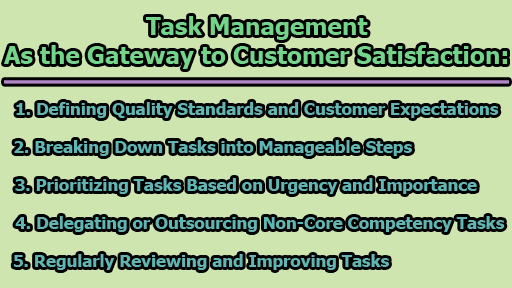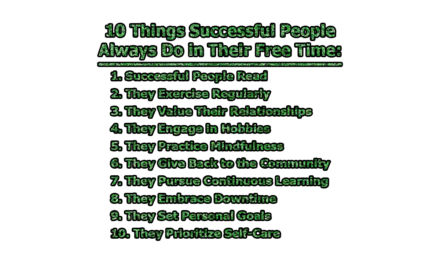Task Management as the Gateway to Customer Satisfaction:
Task management plays a pivotal role in ensuring the delivery of high-quality work and meeting customer expectations. In this fast-paced business environment, understanding and implementing effective task management strategies are essential for success. In the rest this article, we will explore the significance of task management as the gateway to customer satisfaction.
1. Defining Quality Standards and Customer Expectations:
Before undertaking any task, it’s imperative to establish a solid foundation by defining clear quality standards and understanding the expectations of the customers. Quality standards serve as the criteria against which the work will be evaluated, encompassing aspects such as accuracy, completeness, timeliness, and compliance. These standards provide a measurable framework, ensuring that the end product or service meets the desired level of excellence.
To define quality standards effectively, employing tools like SMART goals, checklists, rubrics, and surveys is essential. SMART goals, which are Specific, Measurable, Achievable, Relevant, and Time-bound, offer a structured approach to setting objectives. Checklists and rubrics provide tangible guidelines, outlining specific tasks and criteria for successful completion. Surveys, on the other hand, can be a valuable tool for gathering direct feedback from customers, helping to align quality standards with their expectations.
Similarly, understanding customer expectations is crucial for delivering a product or service that truly resonates with the end-users. Customer expectations encompass a wide range of factors, including functionality, usability, design, and feedback mechanisms. By leveraging tools like surveys, interviews, and market research, businesses can gain insights into what their customers value the most. This understanding not only aids in setting realistic quality standards but also guides the entire task management process towards outcomes that genuinely satisfy the end-users.
2. Breaking Down Tasks into Manageable Steps:
One of the primary challenges in effective task management is dealing with large and complex tasks that can overwhelm individuals or teams. To address this challenge, breaking down tasks into smaller, more manageable steps is a strategic approach. This not only facilitates a clearer understanding of the overall process but also allows for better tracking of progress and identification of potential issues or risks.
Visualization tools play a crucial role in implementing this strategy. Gantt charts, for instance, provide a timeline view of tasks, their dependencies, and deadlines. Kanban boards, with their visual representation of work stages, enable a more agile approach to task management. Flowcharts offer a sequential representation of steps, aiding in comprehending the task breakdown. By utilizing these tools, individuals and teams can organize and manage their workload more efficiently.
Breaking down tasks into manageable steps also promotes a focused approach. By concentrating on one step at a time, individuals can allocate their energy and resources effectively, ensuring that each sub-task receives the attention it deserves. This approach not only enhances the overall quality of work but also contributes to customer satisfaction by minimizing the likelihood of errors and delays.
3. Prioritizing Tasks Based on Urgency and Importance:
Another essential aspect of effective task management is prioritization. The challenge often lies in managing multiple tasks, each with its own set of demands and deadlines. To navigate this complexity, prioritizing tasks based on urgency and importance is crucial.
Urgency refers to the time sensitivity of a task – how soon it needs to be completed. Importance, on the other hand, relates to how much a task contributes to overarching goals and values. Tools such as the Eisenhower matrix, the ABCDE method, or the MoSCoW technique provide systematic approaches to prioritize tasks.
The Eisenhower matrix, for instance, categorizes tasks into four quadrants – urgent and important, important but not urgent, urgent but not important, and neither urgent nor important. This classification aids in deciding which tasks require immediate attention, which can be deferred, and which may need to be delegated or dropped altogether.
The ABCDE method involves assigning a priority level (A, B, C, D, or E) to each task, making it easier to identify and address tasks in order of importance. The MoSCoW technique categorizes tasks as Must-haves, Should-haves, Could-haves, and Won’t-haves, providing a clear roadmap for prioritization.
By employing these prioritization techniques, individuals can streamline their focus, ensuring that they are directing their efforts towards tasks that align with organizational goals and contribute significantly to customer satisfaction. This strategic approach minimizes the risk of being overwhelmed by competing priorities, ultimately leading to enhanced quality in deliverables and a more satisfied customer base.
4. Delegating or Outsourcing Non-Core Competency Tasks:
In the realm of task management, recognizing tasks that fall outside one’s core competencies or demand resources beyond one’s capabilities is a strategic move towards ensuring efficiency and maintaining quality. Delegating or outsourcing such tasks to individuals or entities better equipped to handle them can significantly contribute to overall effectiveness and customer satisfaction.
Various tools and methodologies aid in identifying tasks suitable for delegation. RACI charts, for instance, help clarify roles and responsibilities within a team or organization. RACI stands for Responsible, Accountable, Consulted, and Informed – each role is assigned a label, ensuring a clear understanding of who is doing the work, who is accountable, who needs to be consulted, and who needs to be informed.
SWOT analysis (Strengths, Weaknesses, Opportunities, Threats) can be applied not only to evaluate internal factors but also to identify areas where external expertise might be more beneficial. By assessing strengths and weaknesses, businesses can discern which tasks align with their core competencies and which may be better suited for delegation.
Cost-benefit analysis is another tool that aids in decision-making when considering delegation or outsourcing. By evaluating the costs associated with performing a task internally versus externally, businesses can make informed decisions that maximize efficiency and overall quality.
By adopting a strategic approach to delegation, individuals and organizations can free up valuable time and resources. This, in turn, allows them to concentrate on tasks that align with their strengths, adding more value to their work and enhancing customer satisfaction. Successful delegation not only improves efficiency but also ensures that each task is handled by individuals with the expertise needed, contributing to higher-quality outcomes.
5. Regularly Reviewing and Improving Tasks:
The journey towards quality and customer satisfaction doesn’t conclude upon task completion. Regularly reviewing and improving tasks is an ongoing process that ensures the maintenance of high standards and the adaptability to evolving customer expectations.
Task reviews involve a comprehensive assessment of the quality of work, measurement of results, and collection of feedback from customers. This multifaceted approach provides insights into the effectiveness of the implemented task management strategies and identifies areas for improvement.
Improvement initiatives, in this context, involve a thorough analysis of both the strengths and weaknesses of the completed tasks. Tools such as PDCA cycles (Plan, Do, Check, Act), fishbone diagrams, and the 5 Whys method are instrumental in this process.
PDCA cycles provide a systematic approach to continuous improvement. Planning involves identifying areas for improvement, implementing changes in the ‘Do’ phase, checking the results, and acting upon the findings. This iterative process ensures that tasks are continually refined, leading to enhanced quality.
Fishbone diagrams, also known as Ishikawa or cause-and-effect diagrams, are useful in identifying the root causes of problems or errors. By categorizing potential causes into branches, this visual tool aids in understanding the various factors that may affect task performance.
The 5 Whys method involves asking “why” repeatedly to drill down to the root cause of an issue. By iteratively asking why a problem occurred, individuals can uncover deeper insights and implement targeted solutions.
By integrating these tools into the task management process, individuals and organizations can foster a culture of continuous improvement. Regular reviews and improvement initiatives not only ensure that quality standards are consistently met but also demonstrate a commitment to adapting to changing customer expectations. This proactive approach positions businesses to not only meet but exceed customer satisfaction, creating a positive feedback loop for sustained success.
In conclusion, effective task management is a multifaceted approach that significantly contributes to enhancing quality and customer satisfaction. By defining clear quality standards and understanding customer expectations, breaking down tasks into manageable steps, prioritizing based on urgency and importance, delegating non-core competency tasks, and regularly reviewing and improving processes, individuals and organizations can create a robust framework for success. As businesses navigate the complexities of the modern world, mastering the art of task management becomes a crucial factor in achieving sustainable growth and customer delight.

Library Lecturer at Nurul Amin Degree College










